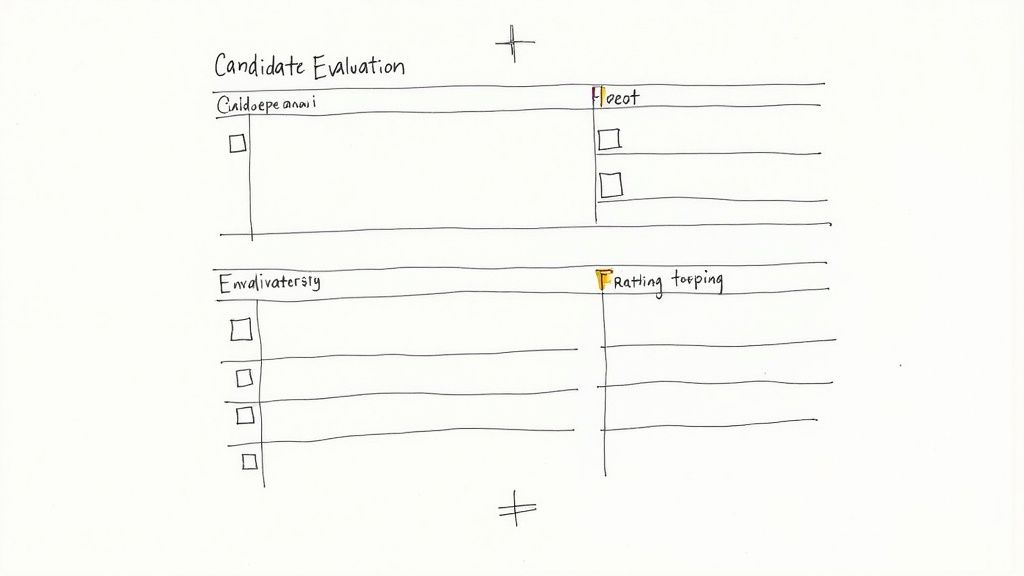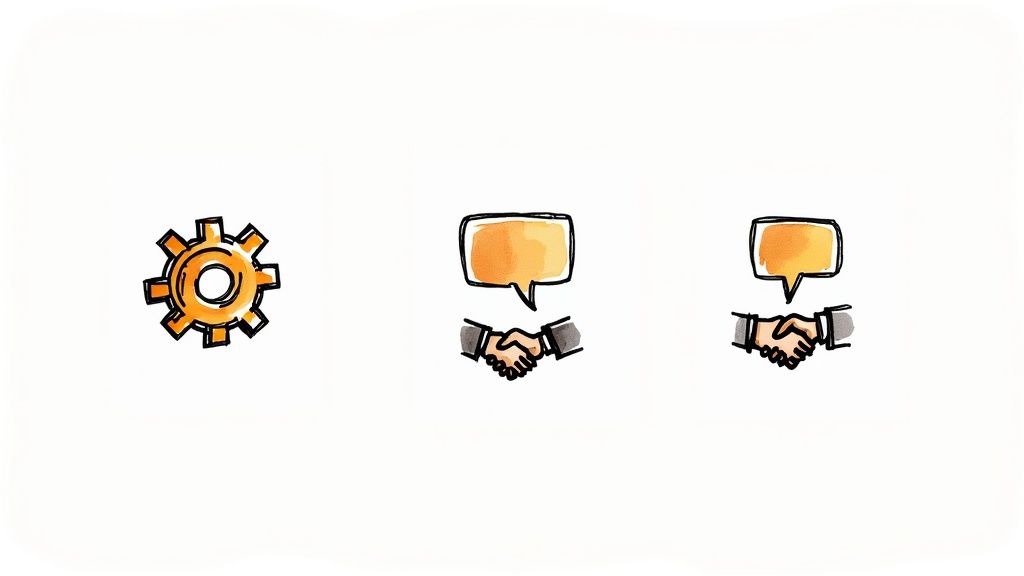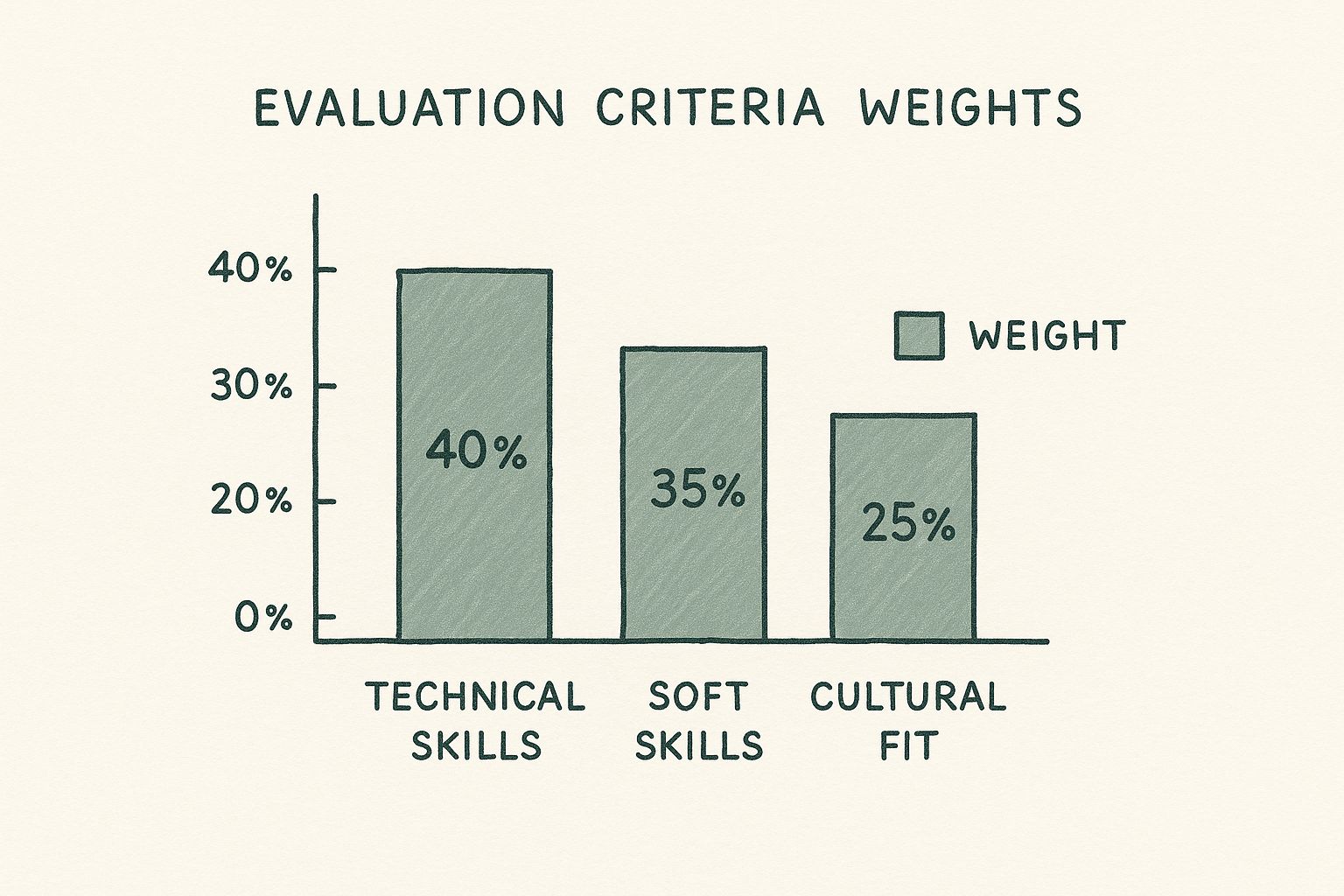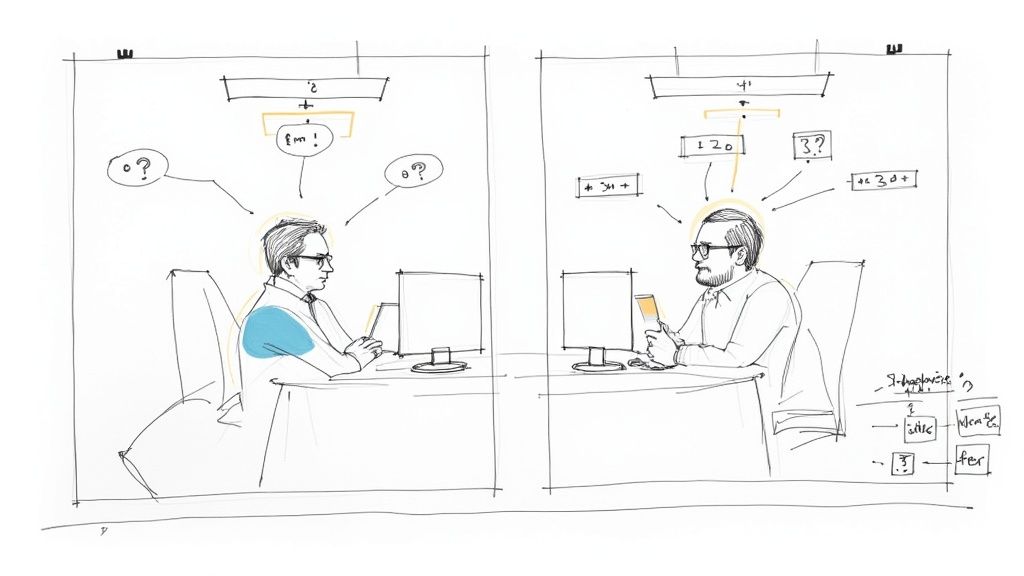Let’s be honest, we’ve all been there. You have a ‘good feeling’ about a candidate. It’s a gut instinct. But in a hiring world this competitive, relying on gut feelings isn't just a risk—it's a liability that almost always leads to biased, inconsistent, and ultimately, bad hires. This is where a standardized candidate evaluation form becomes non-negotiable. It’s the single best tool to shift your hiring from guesswork to objective, data-driven decisions.
Why Gut Feelings Fail in Modern Hiring

Trusting your intuition alone is like trying to navigate without a map. It feels like you're on the right path until you look up and realize everyone on your hiring team is heading in a completely different direction. This kind of unstructured approach is a recipe for chaos, where one interviewer’s “great communicator” is another’s “lacks attention to detail.”
The real problem here is the lack of a common language. Without a standardized evaluation form, every interviewer is left to assess candidates through their own unique lens, which is inevitably clouded by personal experiences and unconscious biases. This makes it practically impossible to compare candidates fairly.
The High Cost of Inconsistent Feedback
Think about this scenario: you have two fantastic finalists for a critical role. One interviewer loves Candidate A’s confidence, but another team member perceives it as arrogance. At the same time, Candidate B’s thoughtful, quieter nature is seen as deep expertise by one person and a lack of engagement by another. Who's right?
Without a form to guide the evaluation, the hiring decision often goes to the loudest or most influential voice in the debrief, not the most reasoned argument. This subjectivity doesn’t just put you at risk of a bad hire; it opens you up to potential legal challenges. A structured form, on the other hand, creates a documented, defensible record of why one candidate was chosen over another, based on criteria directly relevant to the job.
A candidate evaluation form transforms hiring from a collection of opinions into a strategic, evidence-based process. It forces every interviewer to measure candidates against the same yardstick, ensuring fairness and clarity.
This structured approach has a massive impact on the applicant's journey, too. When your process is clear and the feedback is consistent, candidates feel respected. That positive experience is everything—it can be the deciding factor in them accepting your offer and influences how they talk about your company later.
Aligning Evaluation with Candidate Expectations
Today’s candidates expect a professional, transparent, and timely hiring process. A slow or disorganized evaluation can be a huge turn-off. In fact, 48% of candidates reject job offers simply because of slow feedback after their final interviews. This stat alone shows how a tight evaluation process is directly tied to your ability to land top talent.
And it’s not just about speed; it's about communication. A staggering 72% of candidates have dropped out of a recruitment process because of poor communication. A well-designed evaluation framework ensures feedback is collected quickly, so your team can keep candidates in the loop. It’s also worth remembering that 69% of job seekers now share their interview experiences on public platforms like Glassdoor and LinkedIn. Your evaluation process is a key part of your employer brand. If you want to dive deeper, you can explore more of these candidate experience statistics to see how they truly impact hiring success.
A structured evaluation approach gives you a ton of advantages:
- Drastically Reduces Unconscious Bias: By focusing everyone on predefined skills and competencies, you make sure every applicant is measured against the same objective standards. This helps push aside biases related to background, communication style, or just personal affinity.
- Creates a Legally Defensible Record: Every completed form adds to a clear, consistent evidence trail for your hiring decisions. This documentation is invaluable for demonstrating fair practices and compliance.
- Boosts Candidate Experience: A clear, structured process screams professionalism and respect for the candidate's time. This improves their perception of your company and leads to higher offer acceptance rates.
- Improves Decision-Making Quality: The form makes it easy to have apples-to-apples comparisons, fueling data-driven discussions during post-interview debriefs. This alignment helps your team make more confident and accurate hiring choices.
Ultimately, adopting a candidate evaluation form is about moving beyond guesswork. It’s a strategic move to build a hiring machine that is more equitable, efficient, and effective at finding the right people for the right roles, every single time.
Building Your Form's Core Components

A truly powerful candidate evaluation form isn't something you can just download. While templates are a decent starting point, the most effective forms I've seen are always custom-built, designed from the ground up with the specific role in mind. Think of it as creating a blueprint for success, not just a generic checklist.
Your foundation is the job description you already have. Every single part of your evaluation form should map directly back to the requirements and expectations you've outlined there. This is what creates that tight alignment between what you say you want and how you actually measure it.
So, let's get into the nitty-gritty and look at the building blocks that take a form from a simple document to a high-impact evaluation tool.
Defining Your Evaluation Pillars
Before you even think about writing a single question, you need to establish the main pillars of your evaluation. These are the big-picture categories that will organize all your specific criteria. I like to think of them as the main chapters in the story of your evaluation.
For most roles, these pillars boil down to three key areas:
-
Role-Specific Skills: These are the non-negotiables—the hard skills and technical abilities needed to just do the job. For a developer, it's proficiency in a specific programming language; for a financial analyst, it's expertise in financial modeling.
-
Core Competencies: Here, we're talking about the softer, more universal skills that predict success within your company's environment. This is where things like communication, teamwork, problem-solving, and adaptability come into play.
-
Behavioral and Cultural Alignment: This pillar is all about seeing how a candidate's values, work style, and motivations vibe with your team and company culture. It’s not about hiring clones, but about finding people who will be a positive addition to the environment you've built.
Nailing these pillars down first prevents your form from becoming a jumbled mess of questions. It provides a clear, logical flow that makes the whole process more intuitive for your interviewers.
Your goal is to move beyond vague feedback like "good team player." Instead, define what a good team player does. Do they proactively offer help? Do they listen to others' ideas without interrupting? Do they communicate roadblocks clearly?
This level of detail is what separates a truly useful form from a simple box-ticking exercise. As you design your form, it's smart to think ahead. Looking at how well-structured employee onboarding plan templates are built can give you a solid framework for your form's components and your broader HR processes, setting you up for a smooth transition from candidate to new hire.
Crafting Specific and Measurable Criteria
With your pillars in place, it's time to fill them with specific, measurable criteria. This is where the magic happens—you translate the high-level job description into tangible things you can actually observe and rate during an interview.
For instance, don't just have a line item for "Communication Skills." Break it down into observable actions:
- Clarity of Expression: Articulates thoughts clearly and concisely.
- Active Listening: Summarizes or accurately references points made earlier in the conversation.
- Written Communication (if relevant): Provides clear, error-free responses in any written exercises.
This approach forces interviewers to ground their feedback in evidence rather than just gut feelings. They have to back up their ratings with real examples of what the candidate said or did. This is a fundamental principle of creating a fair and objective candidate evaluation form. To dive deeper into different frameworks and see more examples, check out our complete guide on the interview evaluation form.
Including Essential Logistical Details
This part is often overlooked but absolutely critical: the logistical section. This basic information provides essential context and keeps your records complete and easy to find later. Trust me, you'll thank yourself for this down the road.
Your form should always have fields for:
- Candidate Information: Full Name, Position Applied For.
- Interviewer Details: Interviewer's Name, Department.
- Interview Context: Date of Interview, Interview Stage (e.g., Phone Screen, Technical Round, Final Interview).
This admin data is invaluable for tracking a candidate's journey through your pipeline, comparing notes across different interviewers, and maintaining a compliant, organized hiring file.
Finally, every form needs a dedicated space for red flags and a qualitative summary. This is a free-text area where interviewers can note any significant concerns, highlight standout strengths that don't fit neatly into a category, and give their overall recommendation. It’s this blend of structured scoring and qualitative insight that gives you the full, well-rounded picture of a candidate, leading to much more confident hiring decisions.
Choosing a Scoring System That Actually Works
An evaluation form without a clear scoring system is just a page of notes. It's the scoring that transforms your team's gut feelings and qualitative observations into something you can actually compare and defend. That’s the entire point of a candidate evaluation form, after all.
The right system brings immediate clarity to your hiring conversations. The wrong one? It just adds another layer of confusion. Your real goal here is to land on a model that's simple enough for everyone on the hiring team to use consistently but robust enough to lead to confident, data-backed decisions.
From Simple Scales to Weighted Systems
Most teams start with a straightforward numerical scale, usually 1 to 5. It’s easy to grasp and quick to roll out. But for more complex or senior roles, not all criteria are created equal. This is where a weighted scoring system becomes incredibly valuable.
With a weighted system, you’re intentionally giving more importance to the must-have competencies. Think about a senior software engineer role. Technical proficiency might make up 40% of their total score. For an entry-level sales position, however, something like coachability might carry far more weight.
This is a great example of how you can visually prioritize different skill categories for a professional role.

This kind of breakdown makes it crystal clear to every interviewer that while soft skills and culture fit matter, technical skills are the primary filter for this specific hire.
Defining Your Scoring Rubric
Here’s where most teams stumble: they pick a scale but don't define what the numbers actually mean. A "3" to one interviewer could be a "4" to another, and suddenly your "objective" data is useless. This is why you need to build an interview rubric.
A rubric gives descriptive anchors to each number on the scale. For instance:
- 1 – Poor: Candidate lacks the fundamental understanding or skills needed for the role.
- 3 – Meets Expectations: Shows they have the skills to do the job effectively with standard onboarding and guidance.
- 5 – Exceptional: Goes far beyond what's expected; demonstrates advanced skills and the potential to innovate or lead in this area.
The real magic of a rubric is that it forces your hiring team to agree on what "good" looks like before anyone even speaks to a candidate. This one step does more to reduce unconscious bias than almost anything else you can do.
If you’ve ever built a general process scorecard, you’ll find the thinking is very similar. It trains you to create objective, measurable criteria that can be applied consistently—whether you're evaluating a business process or a potential new hire.
To help you decide which approach is right for your needs, here's a quick comparison of common scoring models.
Comparison of Candidate Scoring Models
This table breaks down the most common scoring systems to help you choose the best fit for your candidate evaluation form, depending on the role and how much detail you need.
| Scoring Model | Description | Best For | Pros | Cons |
|---|---|---|---|---|
| Simple Numerical Scale (e.g., 1-5) | Interviewers rate candidates on a basic scale for each competency. | High-volume roles, initial screening stages, or when speed is a priority. | Quick, easy to understand, and simple to implement. | Can be subjective without a rubric; treats all skills as equally important. |
| Descriptive Scale (e.g., Poor to Excellent) | Uses words instead of numbers to define performance levels. | Roles where qualitative feedback is more important than a precise numerical score. | More intuitive for some interviewers; less intimidating than numbers. | Harder to quantify and compare candidates; definitions can still be ambiguous. |
| Pass/Fail System | Candidates are simply marked as meeting or not meeting the minimum criteria for a skill. | Screening for non-negotiable requirements, like certifications or specific tool proficiency. | Very fast and decisive for go/no-go decisions. | Lacks any nuance; doesn't differentiate between good and great candidates. |
| Weighted Scoring System | Assigns different percentage weights to competencies based on their importance to the role. | Senior or highly specialized roles where certain skills are critical. | Provides a more accurate and defensible final score; aligns evaluation with job priorities. | More complex to set up; requires upfront consensus on weights. |
Ultimately, the best model is the one your team will actually use. A weighted system might be the gold standard, but if it’s too complicated for your hiring managers, a well-defined 1-5 scale is a fantastic starting point.
The Hidden Impact of a Fair Process
A well-defined scoring process isn't just an internal tool; it has a direct ripple effect on the candidate experience. When your evaluation feels structured and fair, it contributes to a positive interaction—and that's more critical than ever.
Recent data shows 66% of job applicants accepted offers because of a positive experience during the hiring process. On the flip side, 36% rejected positions after a negative one. This shows just how much influence clear, respectful interactions have on your ability to close top talent.
Of course, using technology to manage this data is key. Many teams get the most out of their evaluation forms by integrating them directly into their workflow. If you're looking to make this part of your process more efficient, exploring options for automated candidate screening can show you how tech can support—not replace—your team’s judgment. It ensures the valuable data you're collecting actually helps you make faster, smarter decisions without losing that essential human touch.
Embedding Your Form into the Hiring Workflow

Let's be honest. Creating a brilliant candidate evaluation form is only half the battle. If it just sits in a shared drive gathering digital dust, it’s completely useless. The real win comes from making it an indispensable part of your day-to-day hiring process.
This is the point where a good idea often fails to become a great process. The goal isn't to add another administrative headache for your hiring managers. It's about weaving the form so deeply into your workflow that it becomes the natural, easy way to make fair and informed decisions.
Training Your Interviewers for Consistency
The biggest make-or-break factor for your form's success? Consistent use. If one interviewer uses it religiously and another wings it, you've lost all the benefits of standardization. This is exactly why dedicated training isn't just a nice-to-have; it's non-negotiable.
Don't just email the form and expect everyone to instantly get on board. You need to run hands-on workshops with your hiring teams. These sessions should go way beyond just explaining how to fill out the fields.
Your training needs to hit these key areas:
- The 'Why' Behind the Form: Start by explaining how it actively reduces bias, lifts the quality of your decisions, and ultimately creates a better experience for the candidate. When people truly understand the purpose, they're much more likely to buy in.
- Decoding the Rubric: Walk through your scoring system in painstaking detail. You need to discuss what a "3 – Meets Expectations" versus a "4 – Exceeds Expectations" actually looks like in practice, using concrete, role-specific examples.
- Spotting and Sidestepping Bias: A huge part of the training is teaching interviewers to recognize their own unconscious biases. Position the form as a tool that helps them refocus their attention on observable skills and evidence-based feedback, moving away from subjective "gut feelings."
I’ve seen this firsthand: the most effective training involves a mock interview. Have the team watch a pre-recorded interview and fill out the form on their own. Afterward, get everyone together to discuss their different scores and observations. It’s a fantastic way to get everyone calibrated and aligned.
This proactive approach ensures your team is speaking the same language from day one. It transforms the form from a simple document into a shared framework for thinking about talent.
Integrating with Your Applicant Tracking System
To make the form truly seamless, it needs to live where your hiring team already spends their time: your Applicant Tracking System (ATS). Manually downloading, filling out, and re-uploading forms is clunky, creates friction, and people will just stop doing it. The good news is that most modern ATS platforms let you build custom forms directly within the system.
This integration is a total game-changer for a few reasons:
- Centralized Data: All your evaluation data gets automatically tied to the candidate's profile. This creates a single source of truth, ending the frustrating hunt through emails and shared folders for feedback.
- A Smoother Workflow: Interviewers can complete their evaluation right after an interview without having to jump between different tools. This simple change dramatically increases the form's completion rate.
- Powerful Analytics: With all your data in one spot, you can start running insightful reports. You'll be able to track interviewer consistency, analyze which skills actually predict success in a role, and pinpoint bottlenecks in your hiring funnel.
In a competitive job market, efficiency and data are everything. We're seeing a major shift from focusing on hiring volume to improving quality-of-hire metrics. With 66% of U.S. talent acquisition professionals tracking time-to-fill and 60% monitoring retention, the data from your evaluation forms becomes critical business intelligence.
The Power of Post-Interview Calibration
The final, crucial step is the post-interview calibration meeting. This is where the magic really happens. A calibration meeting isn't just a casual debrief; it's a structured discussion where the entire hiring team comes together to compare notes and discuss their evaluations.
During this huddle, the form becomes the centerpiece of the conversation. Instead of vague statements like, "I got a good vibe," the discussion shifts to, "I scored them a 4 on Problem-Solving because they walked me through a specific challenge and clearly explained their thought process." This focus on evidence is key.
For practical demonstrations of how technology can enhance these discussions, it's worth exploring examples of interactive tools for career recruiting that can make these calibration sessions even more engaging.
This process quickly uncovers any scoring discrepancies and forces the team to align on a collective, evidence-based decision. It holds everyone accountable, mitigates individual biases, and ensures the final hiring choice is made by the team, not just by the loudest voice in the room. It's the ultimate quality check on your entire process.
Common Pitfalls and How to Avoid Them
You’ve built your form and rolled it out to the team. That's a huge step, but the work isn't over. A great candidate evaluation form can easily be undermined by some common, yet totally avoidable, mistakes.
Let’s be real: a form is only as good as how it’s used. Think of it less as a final product and more as a living document. The moment it gets filed away and forgotten, it starts losing its value. We're going to walk through the pitfalls that can derail your efforts and, more importantly, how to sidestep them.
The Overly Complex Form
One of the biggest mistakes I see is a form that’s just too long and complicated. When you hand an interviewer a five-page document with dozens of criteria, one of two things will happen: they'll rush through it, giving vague feedback, or they'll just stop using it altogether.
The solution? Radical simplicity. Seriously, aim to keep your form to a single page if you can. This forces you to be ruthless about what actually matters for success in the role. If a criterion isn't a critical indicator of performance, it probably doesn't need to be on the form.
This streamlined approach has another huge benefit: it makes those post-interview calibration meetings so much more focused. Instead of getting bogged down in minor details, your team can zero in on the core competencies that will drive results.
Undefined Scoring and Vague Feedback
Another classic trap is failing to clearly define your scoring rubric. If "Meets Expectations" means something different to every single person on your interview panel, then your quantitative data is basically useless. This ambiguity is an open invitation for personal bias to creep right back into the process.
You have to anchor every point on your scale with clear, behavioral descriptions. What does a "5 – Exceptional" candidate actually do or say in an interview? Give concrete examples for each rating to make sure everyone is calibrated and speaking the same language.
A well-defined rubric is a game-changer. It forces a shift from a gut feeling like, "I liked them," to an evidence-based statement like, "I scored them a 4 in Problem-Solving because they clearly articulated their approach to the case study and considered three viable solutions." This is the heart of fair evaluation.
Don't just rely on the numbers, though. A form without a dedicated spot for qualitative notes misses all the crucial context. Nudge your interviewers to jot down specific examples, direct quotes, and their overall impressions. It’s that blend of scores and stories that paints the full picture.
Candidate Evaluation Form Do's and Don'ts
Here’s a quick reference guide to help you keep your process sharp, effective, and free of common missteps.
| Do | Don't |
|---|---|
| Keep the form concise and focused on critical, role-specific criteria. | Overload the form with too many questions or nice-to-have skills. |
| Train all interviewers on how to use the form and rubric consistently. | Assume everyone will use it correctly without clear guidance and calibration. |
| Use open-ended questions that encourage detailed, evidence-based answers. | Rely on simple yes/no questions that don't reveal a candidate's thought process. |
| Schedule regular reviews to update criteria based on new hire performance data. | Let the form become static and outdated, losing its relevance over time. |
| Leave ample space for qualitative notes and specific examples from the interview. | Focus only on numerical scores, ignoring the rich context of written comments. |
Sticking to these principles will help you create a tool that not only standardizes your process but truly elevates the quality of your hiring decisions.
Letting Personal Bias Slip In
Even with a fantastic form, unconscious bias can sneak its way into written comments. Vague phrases like "not a culture fit" without any supporting evidence are a massive red flag. The same goes for subjective comments about personality, like "too quiet" or "overly confident." These are often rooted in bias, not objective observation.
The key is to train your team to anchor all feedback in observable behaviors and skills. Instead of "too quiet," an objective comment would be, "The candidate needed prompting to elaborate on their answers and did not ask questions about the role." This subtle shift from judgment to observation is absolutely critical for a fair and legally defensible process.
Ultimately, this focus on fairness does more than just improve your hiring outcomes. It’s a crucial step when you want to improve the candidate experience and build a stronger, more respected employer brand.
Frequently Asked Questions
Even when you've got a solid process mapped out, questions always pop up when you're rolling out something new. Bringing a candidate evaluation form into your hiring workflow is no different. Let's tackle some of the most common questions hiring managers and interviewers run into.
Think of these as the field notes you need to turn your form from a simple document into a powerful tool for making smarter, fairer hiring decisions.
How Can a Form Actually Reduce Unconscious Bias?
This is a great question, and it's one we should all be asking. A form on its own isn't a magic wand that makes bias disappear, but it's a powerful tool for building a more objective process. The secret is in the structure.
By standardizing the exact criteria you’re evaluating for every single candidate, you force a shift in focus. You move away from vague, subjective feelings and toward concrete, observable skills. An interviewer's thought process changes from, "I just didn't feel a connection," to a more pointed question like, "Did they clearly demonstrate the problem-solving skills we need for this role?" It redirects everyone’s attention back to what actually matters for the job.
The real power of a candidate evaluation form is that it forces interviewers to justify their ratings with specific, behavioral examples. It’s no longer enough to say someone was a "good communicator"; you must document how they demonstrated that skill during the interview.
This simple requirement builds in accountability. It makes it much harder for snap judgments or personal affinities to sneak into the final decision, systematically replacing gut feelings with hard data points.
Should We Create Different Forms for Each Interview Stage?
Yes, you absolutely should. Using a single, one-size-fits-all form is a huge missed opportunity. When you tailor your candidate evaluation form to each stage of your hiring funnel, your entire process becomes sharper and more effective.
Just think about the different goals for each conversation:
- Phone Screen: This is your first pass. You're mainly verifying core qualifications, checking salary expectations, and getting a basic feel for their communication style. The form for this stage should be short and sweet, focused on these go/no-go factors.
- Technical or Team Interview: Now you're diving deep. This is where you get into the nitty-gritty of their abilities. The form needs to reflect that, with detailed sections for specific hard skills, behavioral questions, and how they might collaborate with the team.
- Final (Executive) Interview: The focus here typically shifts to the bigger picture. You're looking at long-term potential, strategic thinking, and whether they truly align with the company's values. The evaluation for this final stage should prioritize these high-level attributes, since the more granular skills have already been vetted.
Customizing your forms keeps each interviewer focused on gathering the most important information for their specific part of the journey.
When Should Interviewers Fill Out the Form?
The answer is simple: immediately after the interview ends. This rule should be non-negotiable.
The longer an interviewer waits, the fuzzier their memory gets. Their feedback becomes much more vulnerable to being influenced by other conversations, their own biases creeping back in, or just plain forgetting crucial details.
Even a delay of a few hours can blur the specifics—the exact phrasing a candidate used to answer a key question, the nuance in their problem-solving approach, or a subtle red flag that's easy to dismiss later. Filling out the form while the conversation is still fresh is the only way to ensure the feedback is accurate, detailed, and truly fair.
Make it a mandatory step right after hanging up the call or walking out of the room. This solidifies the form's role as an integral part of the interview itself, not just some administrative chore to be dealt with later.
Ready to make your hiring process faster, fairer, and more effective? Async Interview provides the tools you need to streamline evaluations with asynchronous video interviews, AI transcription, and collaborative features. Discover how Async Interview can transform your hiring workflow.




